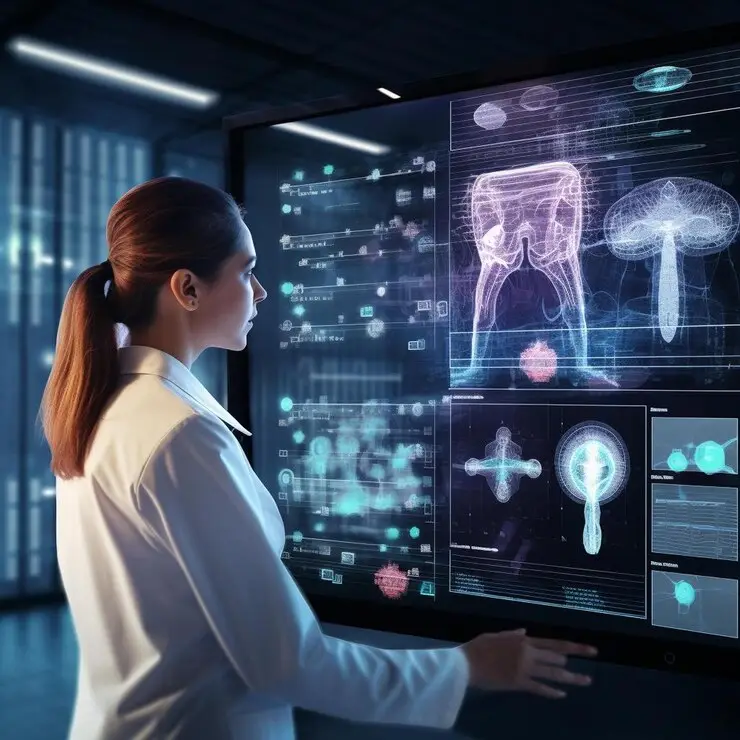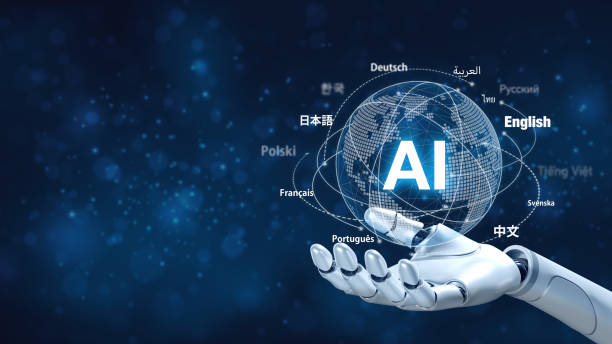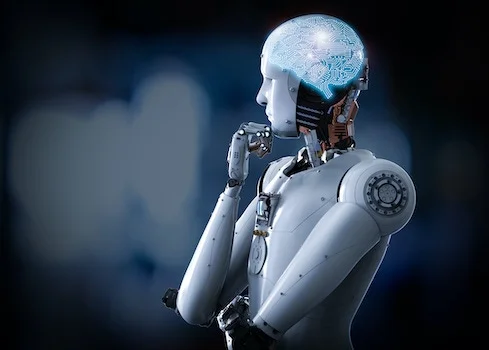Artificial Intelligence (AI) is no longer just a futuristic concept—it is a transformative force reshaping the landscape of medicine and healthcare. In recent years, the integration of AI into medical diagnostics has revolutionized the way healthcare professionals approach disease detection, treatment, and patient care. The possibilities seem limitless, from enabling faster, more accurate diagnoses to enhancing personalized treatment plans and predicting disease outbreaks.
At the core of this transformation is machine learning, a subset of AI that enables systems to “learn” from vast amounts of data and make predictions or decisions without explicit programming. In the field of healthcare, this means AI algorithms can analyze medical data—ranging from patient records to imaging scans—and offer insights that were previously beyond human capacity. With the potential to save lives, reduce costs, and streamline healthcare systems, AI is poised to take healthcare to new heights.
But how exactly is AI revolutionizing medical diagnostics? In this article, we will explore the exciting developments in AI-driven medical diagnostics, examining the technology, applications, challenges, and future potential of AI in transforming healthcare.
The Role of AI in Medical Diagnostics: An Overview
The concept of using AI in healthcare isn’t new. Early applications date back to the 1970s, when medical experts began using computer-assisted systems to aid in diagnosing diseases. However, the true potential of AI only became apparent with recent advances in computational power, big data, and machine learning algorithms. These breakthroughs have given rise to AI systems capable of handling and analyzing complex medical data at an unprecedented scale and speed.
Medical diagnostics traditionally relies on physicians’ expertise and experience, alongside medical tests and imaging. However, diagnostic errors—whether due to human factors, limitations of technology, or time constraints—remain a significant challenge in healthcare. AI promises to reduce these errors by enhancing the accuracy of diagnostic processes and providing real-time insights that guide clinical decision-making.
AI systems can analyze patient data in ways that were once unimaginable. From medical imaging to genomics, AI is revolutionizing the diagnostic process by enabling more rapid, more accurate, and more personalized diagnoses. But how does it work, and why is it such a game-changer in modern medicine?
Machine Learning and Deep Learning: The Core Technologies Behind AI Diagnostics
To understand how AI is reshaping medical diagnostics, it’s essential to first understand the core technologies behind it: machine learning (ML) and deep learning (DL). These are subsets of AI that allow machines to learn from data and improve their performance over time, without being explicitly programmed.
Machine Learning: Learning from Data
Machine learning, the foundation of modern AI, allows algorithms to identify patterns and make predictions based on data. In medical diagnostics, ML algorithms can be trained to recognize patterns in a wide range of medical data, from electronic health records (EHRs) and lab test results to imaging scans and genetic profiles.
For example, a machine learning algorithm might be trained on thousands of X-ray images to identify features indicative of lung cancer. As the algorithm is exposed to more data, it becomes increasingly accurate in detecting the subtle signs of cancer that even the most experienced radiologists might miss.
Deep Learning: Mimicking the Human Brain
Deep learning, a more advanced subset of machine learning, involves the use of artificial neural networks—systems inspired by the structure and function of the human brain. Deep learning algorithms are capable of processing vast amounts of unstructured data, such as images, text, and sound, and making complex decisions based on that data.
In medical diagnostics, deep learning has shown extraordinary promise in analyzing medical images like X-rays, CT scans, and MRIs. These AI systems can learn to recognize and classify different types of tissues, anomalies, and diseases, providing diagnostic support that can match or even exceed human experts in certain areas.
By training deep learning models on massive datasets, AI systems are able to “see” patterns in medical images that are often invisible to the naked eye. This ability to detect abnormalities early in the disease process is one of the most powerful aspects of AI-driven diagnostics.
AI in Medical Imaging: A Game Changer in Diagnostics
Medical imaging has long been an essential component of diagnostic medicine. From the earliest days of X-ray technology to the most sophisticated MRI and CT imaging systems, medical imaging has played a pivotal role in identifying and diagnosing diseases. However, interpreting these images requires not only technical skill but also years of experience.
AI is revolutionizing medical imaging by providing tools that can analyze these images far faster and with greater precision than human experts. The use of AI in imaging is a prime example of how the technology is transforming diagnostics, particularly in fields like radiology and pathology.
AI in Radiology: Detecting Disease Early
Radiology is one of the primary areas where AI is having a profound impact. Algorithms trained on millions of medical images are now capable of detecting and diagnosing a wide range of conditions, from broken bones to tumors and other abnormalities. In particular, AI has shown immense promise in diagnosing cancers, including lung cancer, breast cancer, and skin cancer.
One of the most significant advantages of AI in radiology is its ability to detect minute abnormalities that may go unnoticed by human radiologists. Early detection is crucial in cancer care, as it greatly increases the chances of successful treatment and survival. AI systems can assist radiologists by flagging suspicious areas of images, allowing doctors to make quicker, more informed decisions.
AI’s ability to continually learn and improve from large datasets further enhances its effectiveness. The more images AI systems are exposed to, the more accurate they become in identifying patterns that correlate with specific diseases or conditions. This means that AI can act as a powerful second opinion, helping doctors to avoid diagnostic errors and providing confidence in difficult cases.
AI in Pathology: Revolutionizing Tissue Analysis
Pathology involves examining tissue samples to diagnose diseases, including cancer. Traditionally, pathologists analyze slides under a microscope, looking for signs of abnormalities in cells and tissues. While this process is effective, it is also time-consuming and subject to human error.
AI is changing the game in pathology by automating and enhancing tissue analysis. Through the use of deep learning, AI systems can examine tissue samples with greater precision and consistency than human pathologists. AI algorithms can identify key features of tissue samples, such as cell shapes, sizes, and arrangements, and flag potential issues for further investigation.
In cancer diagnostics, for instance, AI can identify cancerous cells in biopsy samples with a high degree of accuracy. By automating the process, AI reduces the burden on pathologists and allows them to focus on more complex tasks. Additionally, AI systems can analyze large volumes of tissue samples quickly, speeding up the diagnostic process and improving turnaround times.
AI and Predictive Diagnostics: A Step Towards Personalized Medicine
One of the most exciting applications of AI in medical diagnostics is its potential to predict diseases before symptoms appear. By analyzing patterns in a patient’s medical history, lifestyle factors, genetic data, and environmental exposures, AI systems can identify individuals at high risk for certain conditions, such as heart disease, diabetes, or cancer.
AI in Predicting Chronic Diseases
For example, machine learning algorithms can predict a person’s risk of developing cardiovascular disease by analyzing data from EHRs, including age, gender, blood pressure, cholesterol levels, and family history. AI can also incorporate lifestyle factors, such as diet and physical activity, to provide a more comprehensive risk assessment.
Similarly, AI is being used to predict the onset of diabetes by analyzing factors like blood glucose levels, body mass index (BMI), and genetic predisposition. Early detection of these conditions enables healthcare providers to intervene before the disease progresses, potentially preventing serious complications and improving patient outcomes.
AI and Personalized Treatment Plans
AI’s ability to analyze vast amounts of data and generate predictive models also plays a key role in personalized medicine. Personalized medicine refers to tailoring medical treatment to the individual characteristics of each patient, based on factors such as genetics, lifestyle, and environment.
By integrating genetic data, AI can predict how a patient will respond to specific treatments or medications. This allows doctors to choose the most effective therapy based on a patient’s unique genetic makeup, reducing the risk of adverse effects and improving treatment outcomes.
In cancer treatment, for instance, AI can analyze the genetic mutations present in a tumor and recommend targeted therapies that are more likely to be effective. This level of precision medicine is transforming oncology, offering patients treatments that are specifically designed to target the molecular underpinnings of their cancer.
AI in Genomics: Unlocking the Secrets of the Genome
The field of genomics is another area where AI is making a significant impact. With the advent of next-generation sequencing (NGS) technologies, it is now possible to sequence an entire human genome in a matter of days. However, interpreting this vast amount of data remains a complex challenge.
AI is playing a critical role in genomics by helping to decode genetic data and identify mutations or variations that could be linked to disease. Machine learning algorithms can analyze DNA sequences and predict which genetic variations are likely to cause disease. In cancer genomics, for example, AI can help identify specific mutations in tumor DNA that drive cancer growth and suggest potential treatments based on these mutations.
Furthermore, AI is helping to uncover the role of genetic variants in complex diseases like Alzheimer’s and Parkinson’s disease. By analyzing large genomic datasets, AI can identify new genetic markers associated with these conditions and provide insights into their underlying mechanisms.
Challenges and Ethical Considerations
While AI’s potential in medical diagnostics is immense, it is not without challenges. The use of AI in healthcare raises important questions about data privacy, security, and the role of human expertise in decision-making. As AI systems become more integrated into medical practice, ensuring that they are transparent, explainable, and accountable will be crucial.
One of the primary concerns is the quality of data used to train AI models. AI systems require large, high-quality datasets to function effectively, but healthcare data is often incomplete, biased, or inconsistent. Ensuring that AI algorithms are trained on diverse, representative data is essential to avoid perpetuating healthcare disparities.
Another challenge is the trust factor. While AI can assist in diagnosis, it cannot replace the expertise, experience, and empathy of human doctors. Patients must trust that AI will enhance, rather than replace, the role of their healthcare providers. Ensuring that AI systems are used as tools to support doctors, rather than replace them, will be essential to maintaining trust in the medical profession.
The Future of AI in Healthcare
Looking ahead, the role of AI in medical diagnostics is set to expand even further. As AI continues to evolve, it will become increasingly integrated into clinical workflows, enabling real-time diagnostics and decision-making. The potential for AI to revolutionize healthcare is immense, from improving patient outcomes and reducing healthcare costs to accelerating the development of new treatments and therapies.
Ultimately, the goal is to create a healthcare system that is faster, more efficient, and more personalized, with AI working alongside healthcare professionals to provide the best possible care. While challenges remain, the future of AI in medical diagnostics holds great promise, and its potential to transform healthcare for the better is just beginning to be realized.






